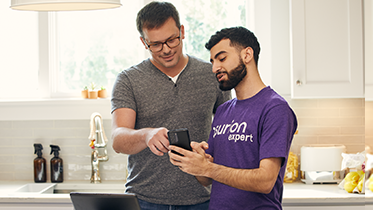Imagine preparing for a weekend get-together and reaching into your freezer, only to find out that your KitchenAid® ice maker isn't working. So much for that steady supply of ice. Don't worry though—we’ve got you and your appliances covered. At Asurion, we understand how important it is for your kitchen appliances to do what they’re supposed to. Let's explore some common reasons why your KitchenAid ice maker has stopped working—and what you can do to fix it.
Reasons your ice maker has stopped working. There are many reasons your ice maker may no longer be making ice. Follow these tips to identify the problem.
The ice maker is turned off
Sometimes, the solution is as simple as making sure the ice maker is turned on. Check the control arm or switch to ensure it’s in the correct position.
The freezer temperature is too high
The freezer temperature needs to be just right for your ice maker to work as it should. If it’s too high, it can stop producing ice.
Aim for a freezer temperature of 0°F. This temperature is perfect for freezing food without driving up your utility bill. Unsure of your freezer’s temperature control gauge? Check your freezer’s manual.

Psst... Got 2 minutes?
That’s how long it takes to get a care plan personalized for you:
✓ Coverage for thousands of devices ✓ Fast, quality fixes
✓ Hands-on help when you need it
A clogged water filter
A clogged water filter means you’re not getting new water into your machine, and no water means no ice. Changing the filter might be the fix you need.
First, you’ve got to find it. Use your owner's manual or the manufacturer's website to find out where to locate the filter. If you need help on how to change the filter, the manual or the website is where you’ll want to start.
The water inlet valve is not working
The water inlet valve opens to supply water to the ice maker. If it's malfunctioning or not receiving power, there won’t be any water available to make ice.
Inspecting your refrigerator's water inlet valve is quick and won't harm your fridge's contents if the door remains closed. Start by turning off the water supply and unplugging the fridge. Locate the water valve—often found at the fridge's bottom rear—then disconnect the water supply tubing. Be sure to place a bucket underneath to catch drips. Check for clogs in the debris screen inside the tubing, which can be cleaned with soap and water or a mineral dissolver. If the fill tube is frozen, you can try increasing water pressure to fix the issue.
Ice is jammed in the ejector's arm
Ice can sometimes get stuck in the ejector arm—also known as the ice chute—preventing you from making new ice. Inspect the chute for any blockages. If you find one, gently remove the ice to see if it solves the problem.
Reliable protection for the major appliances you rely on
When your appliances don't work, we do. With Asurion Appliance+®, you get hassle-free coverage and 24/7 troubleshooting support for your current and future appliances—no matter the brand or where you bought them. But it’s not the only care plan we offer. Take our 2-minute quiz to find the right care plan for your appliances and tech, or learn more about how you can get total peace of mind with Asurion Appliance+.




